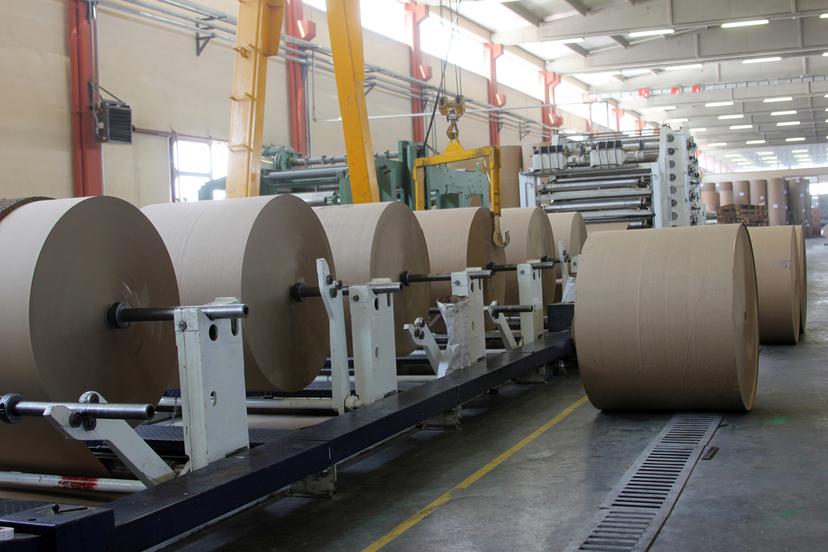Pulp and Paper

Background
Before pulp-derived paper was manufactured, the ancient Egyptians wrote on a paperlike material made by cutting papyrus reeds into strips, arranging them in perpendicular crisscross patterns, and pounding them into sheets. The pressure released a glue-like sap that bound the strips together. In 105 A.D., Ts'ai Lun of China invented pulp-derived paper using fiber from mulberry trees. This proved to be much cheaper and easier to produce than the silk and wood that had been used for a vast number of official documents during the Han dynasty. In spite of his discovery, however, wood was not used in the making of paper for the next 2,000 years. Instead, materials such as old fishing nets, rags, and hemp rope were used.
During the golden age of Islamic culture in the eighth century, the Arabs took a great interest in paper, establishing a mill in 795. The use of paper traveled slowly to the Western world. During the years when the Chinese and the Arabs were developing paper and books, most Europeans were illiterate, with the exception of the clergy. Therefore, most of the books produced were religious works, created by monks. They painstakingly produced beautifully handwritten and illustrated bibles on vellum, which is skin from an unborn calf. This process of book production dominated Europe throughout the Middle Ages, so, while the European traders and crusaders had been exposed to paper much earlier, the first mills did not appear until the 14th century.
It was not until the invention of the printing press by Johannes Gutenberg in the mid-1400s that paper became an essential product for Europeans. Paper manufacturers at that time used a combination of rags and wood to make the pulp needed to produce durable paper. Paper was made one sheet at a time, by dipping a screen into a basin of pulp. The screen was then lifted, and as the water dripped through, the remaining pulp settled evenly on the screen. After sufficient drainage, the settled pulp was lifted from the screen, pressed, and dried. Thus, the size of the sheet was limited to the size of the screen.
There were very few improvements or changes in papermaking until the early 1800s, when Nicolas-Louis Robert invented a moving screen belt that enabled paper manufacturers to produce paper in one continuous sheet. In England, the Fourdrinier brothers improved the technique only a decade later, and the process they developed still bears their name. In addition, in the mid- to late 1800s, producers began using wood fiber, such as groundwood and sulfite pulp, to make paper.
While the technology for paper production has improved over the years, the basic process has not changed. Pulp is created by either grinding the wood (today steel refining disks are used rather than the original stone grinding wheels) or, for the higher grades, cooking the chips under pressure with various chemicals to free the cellulose fibers. The pulp is filtered through screens and cleaned, then sluiced onto an endless wire screen in a one-half percent concentration, where the paper is formed. The paper is then pressed, dried on a series of steam-heated drums, and wound on huge rolls. The entire process is controlled by a sophisticated computerized control system, usually known as a distributed control system.
The pulp and paper industry today manufactures a wide variety of paper products. The commercial printing industry uses tons of paper daily for books, newspapers, magazines, advertising promotion pieces, manuals, and catalogs. Businesses also use large volumes of paper for their computers, copying machines, and fax machines, along with more traditional uses in record keeping, communication, and billing.
Paper and paperboard for packaging and shipping containers constitute the largest tonnage sector of the paper industry. Shipping containers, also called fiber boxes, require millions of tons of paper and paperboard annually. Paperboard cartons of all types are also used to package almost all of the prepared foods, soap products, cosmetics, and similar products used in daily life.
Paper and paperboard are used to package items as light as needles, as heavy as refrigerators, as fragile as eggs, and as massive as motors. Infinitely thin or indestructibly strong, water repellent or water resistant, tissue-soft or cardboard-tough, disposable or permanent, paper and paperboard have an essential daily role in the shipping, wrapping, marketing, selling, and delivery of products that make up every phase of the daily economy of the United States.
More than half of the production of U.S. pulp and paper is in the Southern states. Many of the larger mills produce pulp, as well as paper, and some also produce finished paper products. Much of the newsprint used in the United States, however, comes from Canada. It is estimated that Canadian paper mills supplied more than 32 percent of the newsprint to U.S. newspaper publishers in 2018.
Since the beginning of the 21st century, the paper industry has shrunk in size, primarily due to an increase in use of the Internet for publishing and direct marketing. Concerns about the environment have also led to an increased use of recycling and decreased paper use. The industry has responded by reforesting processes and addressing pollution issues.
